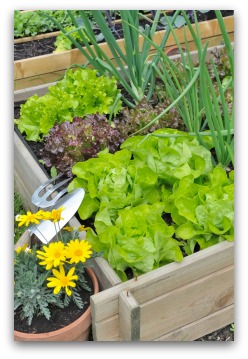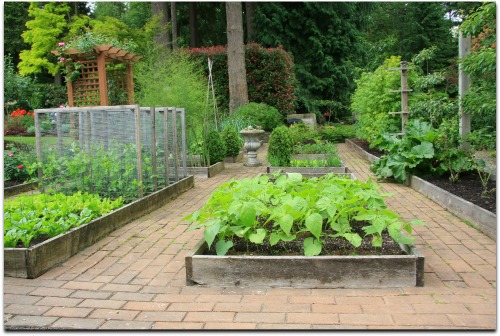Building a Raised Vegetable Garden at Home
Here are a few easy tips for building a raised vegetable garden at home!
Learn our quick ways to build raised beds; also planting and watering tips for raised gardens.
Design Your Own Vegetable Garden Layout Using our Free "Vegetable Garden Planner" Software!
Ideas for Building a Raised Vegetable Garden
After mastering gardening in the traditional flat site, it may be time for you to move up to building a raised garden.
The advantages of using raised beds include allowing no-digging gardening methods, giving block planting preference over rows, and to making crop rotation simpler.
Download Free Garden Planning Worksheets, Garden Diary, Zone Chart, Or Planting Guide
Many gardeners find this type of gardens to be easier to manage than the conventional backyard in-ground method .
Over time as the beds are built up as materials are added, the soil texture becomes much improved.
Building a Raised Bed Vegetable Garden Weekend Project Video
Many Benefits of Gardening
in Raised Beds
When building a raised garden, if the paths are cleared regularly, the scrapings placed on top of the beds soon help build up more height.
Other benefits of raised beds are better microclimates and the higher working level saves your back from constantly bending over.
Building a raised bed is one of the best ways of managing the soil.
Using this technique the gardener has an increased surface area, which promotes aeration and warms the soil very rapidly in the springtime.
Cold air rolls off the beds, keeping the top slightly more frost-free.
Crops also winter better as becoming waterlogged is highly unlikely when building a raised vegetable garden.
- Plant taller-growing vegetable plants on the north end of the raised garden.Wat
- er as needed; raised beds will dry out more quickly than in-ground gardens.
Raised Gardens Warm Quickly and Dry More Quickly
- With all the advantages, there can also be some slight disadvantages to building a raised bed.
- For example, raised beds tend to dry out a bit more quickly throughout the year.
- This kind of gardening does require more watering before sowing or transplanting.
- Light rain penetrates a raised bed but heavy downpours may just run off if you build the rounded or mounded-type raised bed.
- Also, on mounded beds, mulches tend to slide away, making it necessary to clear pathways frequently.
Building a Raised Vegetable Garden Tip
Align raised beds north to south to maximize sunshine and prevent excessive shading.
Raised Bed Garden Designs and Plans
- A size of 4 feet by 16 feet is ideal for building a raised bed.
- Any wider makes the middle too hard to reach.
- Any length that fits your landscape is fine.
Building a Raised Vegetable Garden with Sides
- Raised beds with rigid sides are a bit more expensive to set up in terms of both time and materials.
- Additionally, the materials used to form the sides can provide a hidden shelter for garden pests.
Building a Raised Vegetable Garden Mound
- Alternatively, mounding the soil with slopes on all sides maximizes the growing area and does away with the need for inflexible edges.
- The varying slopes in building a raised bed allow each section its own micro-climate.
- This action benefits the gardener by being able to use individual sections for different vegetables or to extend the cropping season.
South End of Raised Bed Garden is Warmer than North End
The south-facing drier, hotter end of the raised bed will always crop ahead of the cooler, moister, north-facing side.
In addition, the sides will be cool and more protected compared to the warmer upside of the raised bed.
The two ends of a raised bed are ideally suited for growing companion border plants.
You use the area to put Mediterranean herbs at the hot south end and the moisture-cravings crops on the shadier north slant.
This leaves the bulk of the bed for the main plantings.
Planting within each single bed can still be in rows, but for most gardeners, block planting proves to be more successful.
Building a raised bed will save you work compared to row planting.
Since the paths of a raised bed are not walked on, the soil does not become compacted which saves you from needing to dig.
Oh, what a relief that is!
You might also like to read:









